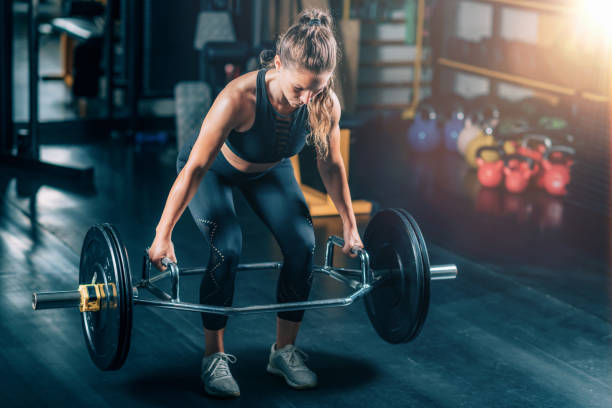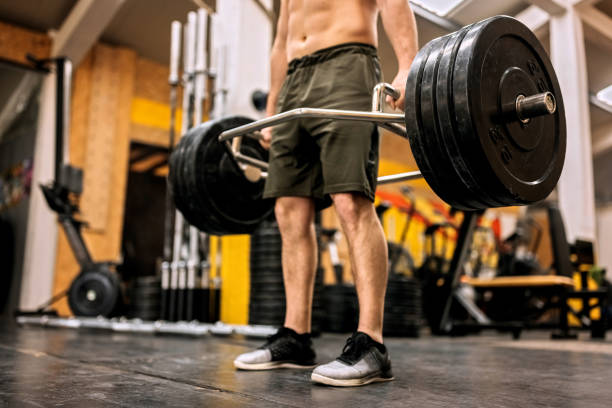Split Stance Trap Bar Deadlift Exercise: Variation That Builds Muscle
Enhance Your Deadlift with the Ultimate Trap Bar Split Stance Exercise Guide
The trap bar deadlift is a hugely popular lower body exercise that builds impressive strength and muscle. However, the regular trap bar variation does have some limitations in terms of unilateral leg development and posture.
That's where trap bar split stance deadlifts come in - offering a killer unilateral exercise to enhance your hinge pattern, posterior chain strength, and muscle building potential.
This in-depth guide will cover everything you need to know to perform trap bar split stance deadlifts with proper form and get the most out of this juicy accessory movement.
We'll break down the key benefits this variation offers over regular trap bar deadlifts, muscles worked, ideal loading parameters, form cues, and more.
Let's get started!
What are the Advantages of the Trap Bar Split Stance Over Regular Trap Bar Deadlifts?
The main benefit of the trap bar split stance is allowing you to load one leg at a time with heavier loads that would be impossible to replicate with any other unilateral movement.
By separating it from the latter, you can directly target unilateral weaknesses that often manifest during regular bilateral lifts.
How Much Weight Can You Use for Split Stance Trap Bar Deadlifts?
Most men should be able to use 70-80% of their trap-bar deadlift 1RM, which would equate to roughly 350-400 pounds for the average intermediate lifter.
Moreover, the limited torso rotation allows for heavier loading than comparable single-leg deadlift variations.
What Muscles Do Trap Bar Split Stance Deadlifts Work?
This exercise hammers the posterior chain - with enormous amounts of tension placed onto the hamstrings, glutes, lower back, traps, and grip.
The front leg also receives plenty of benefit as it works to stabilize during the pull.
Your core will also fire hard to maintain a neutral spine alignment under load.
What’s the Ideal Foot Position for Trap Bar Split Stance?
Generally a staggered stance works best - with the non-working leg placed behind the working leg. You can experiment with heel-to-toe stance for an added balance and stability challenge.
Keep the working leg positioned under your hips for optimal leverage. Your torso should remain upright, with a strong arch in the lower back.
How Many Sets and Reps Should You Perform?
We recommend performing 2-4 sets of 6-10 reps per leg, keeping a 1-2 rep max in the tank on all sets. This allows for sufficient strength adaptation while keeping quality form.
Take 90-120 seconds rest between sets. Over time, work your way up to 3-5 total working sets.
What Form Cues Should You Follow On Each Rep?
- Initiate the pull by driving through your mid-foot, loading the working leg
- Keep the non-working foot grounded, pressing the heel into the floor
- Maintain tension on working hamstring and glute throughout motion
- Hinge at hips, minimizing knee bend until the top portion
- Control eccentric, hinging at the hips again on the way down
- Keep chest upright and core engaged throughout
Finish by performing even sets for both legs. Address any stability or strength imbalances between sides.
What Mistakes Should Be Avoided?
Take care to avoid these common technique flaws:
- Allowing knees to cave inward excessively
- Letting the non-working leg rise off the ground
- Overarching the lower back and losing neutral spine
- Not engaging the glutes and hamstrings sufficiently
- Using momentum rather than controlled form
How Can You Progress This Exercise Over Time?
Here are some ways to progress trap bar split stance deadlifts:
- Increase load in small increments
- Perform more total reps or sets
- Reduce rest times between sets
- Use paused reps to maximize time under tension
- Add chains or bands for extra resistance
The Takeaway
If you aren't already incorporating trap bar split stance deadlifts into your training, you're missing out on a phenomenal posterior chain and single leg exercise.
Implementing this movement can help build unprecedented unilateral leg strength, power, and muscularity. Just be sure to master form first before increasing load or volume.
The staggered split stance allows heavier loading than virtually any other single leg variation.
Put it to good use! Your legs and back will thank you.
Most Important Points to Remember
- Enormous tension placed onto working leg
- Heavier loads than other unilateral variations
- Hamstrings, glutes, back work extremely hard
- Maintain upright posture and neutral spine
- Control eccentric portion to maximize benefit

FAQS About Deadlift Variations
What are the main advantages of trap bar RDLs over regular trap bar deadlifts?
Trap bar RDLs provide greater range of motion and allow for more emphasis on the hamstrings compared to regular trap bar deadlifts. The ability to start from a lower torso position also provides a slightly greater range similar to single-leg deadlifts. Overall, trap bar RDLs enable more posterior chain activation.
How can unilateral trap bar variations help improve imbalance and fitness?
Unilateral trap bar variations like the split stance deadlift highlight any unilateral bias between your legs, helping address imbalances. By forcing each leg to work independently without the other leg being able to compensate, unilateral training builds balance and core stability. This translates to better performance in bilateral lifts and overall fitness.
Why can you use heavier loads with the trap bar split stance?
With one leg grounded behind you acting as a kickstand, the trap bar split stance allows for placing enormous amounts of tension onto the working leg. These far heavier loads than could normally be used for regular unilateral moves results in more strength and muscle gains.
How does the trap bar split stance deadlift benefit the back leg?
Although the back leg isn’t moving much during trap bar split stance deadlifts, having to balance on one leg while forcefully pulling requires immense stability, improving ankle and hip strength. This allows the back leg to contribute more during regular deadlifts, squats, and other lifts.
What changes in technique occur with the trap bar split stance?
Since the non-working leg is grounded, there is less concern over balance. This allows lifters to better maintain an upright torso position during the initial pull, which in turn can promote a bit more glute activity compared to more hip-hinged single leg variations. The reduced freedom of movement also discourages using momentum.

Target Hamstrings Like Never Before
As a trainer, I'm always seeking out the most heroic exercises to annihilate my clients' hamstrings.
Well folks, I have found the Holy Grail - the trap bar split stance deadlift. This baby takes the trap bar RDL and cranks it up to 11 by allowing you to use 70-80% of your max trap bar deadlift, per research from the National Strength and Conditioning Association (https://www.nsca.com).
By having one leg firmly planted (thing separating it from a traditional RDL), you can use far heavier loads than normal. We're talking loads reserved for aggressive powerlifters! This equates to gains for days in the hammies and glutes.
I'm telling you - DOMS like never before. Just ask Johnny who needed a wheelchair after our last "hamstring day" :)
Enhance Balance Beyond Your Wildest Dreams
Sure, improving balance may not be as glamorous for some gym-goers. But here's the tea sis - balanced, stable ankles and hips prevent injury.
And no one wants to be sidelined by a rolled ankle like poor Johnny last month when he tried running sprints for the first time (#prayforjohnny 🙏).
The trap bar split stance enhances ankle and hip stability like nothing I've ever seen. By standing on one leg and forcefully moving hundreds of pounds, your body has no choice but to balance and brace properly. Not to mention overcoming unilateral weaknesses that can manifest during squats and deads.
Research confirms it too! According to the Journal of Strength and Conditioning Research (https://journals.lww.com/nsca-jscr), unilateral training boosts core stability and reduces injury risk. Guess Johnny won't be rolling any more ankles! 😉

Conclusion
The trap bar split stance deadlift checks all the boxes - builds scary hamstring strength, enhances mobility and balance, teaches proper bracing, blasts the glutes and back while unveiling unilateral deficiencies.
Really it's the perfect exercise. Take it from me and poor ol' Johnny! Now let's get to work and catch these gains! 💪

